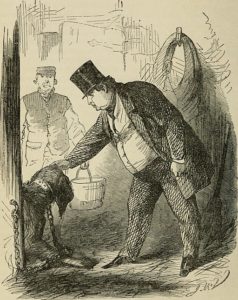
“Count Fosco and the Dog” from The Woman in White (New York: Harper, 1873). Image courtesy Wikimedia Commons.
by Sophia Hsu
Like the Victorians, we in the contemporary West are not as liberal as we think. The idea that the West is the world’s timeless arbiter of freedom is a myth that has been ingrained in our thinking since at least the nineteenth century. Whig historians such as Thomas Macaulay were largely responsible for creating this myth by obscuring English liberalism’s violent, erratic past—a myth that twenty-first-century Britons, Americans, and other Western peoples have inherited and rewritten for their own stories about their respective nations’ foundings.
In my article, I show how Wilkie Collins’s The Woman in White disrupts the liberal fantasies Victorians liked to tell about themselves. Through its Italian characters Pesca and Fosco, the novel shines a light on English liberal hypocrisy, exposing the fallacy of England’s self-perception as a liberal sanctuary. Collins might seem like a strange figure to discuss to problematize the West’s liberal narratives. For a while, Victorianists viewed his sensation novels and the sensation genre in general as complicit in liberal ideology.[1] More recently, however, scholars argue that sensation fiction is more critically sophisticated than previously believed.[2] With my article, I join these scholars in illuminating the critical capacity of sensation fiction. Through my rereading of The Woman in White, then, perhaps we can not only reconsider the political function of the sensation genre but also remind ourselves of liberalism’s entanglement with violence, thus providing us with a model to unsettle our own complacencies about our national histories and identities.
Indeed, in revisiting my article to write this blog post, I’ve become increasingly struck by the continued relevance of Collins’s critique. As a Victorianist living in the U.S., I find myself thinking a lot about what it means to do Victorian studies in the age of Trump. I know I’m not alone in such contemplation. In addition to the many conversations I’ve had with friends, family, and colleagues, I’ve read numerous articles and blog posts that tackle this very question: what role do we as scholars of Victorian literature and culture play in what feels like a heightened time of racism, white nationalism, sexism, distrust, etc.?[3] My first answer usually lies in the significance of teaching and modeling critical thinking. Entangled with this is my second answer: teaching students how to think critically means giving them the tools to “historiciz[e] the present.”[4]
The importance of historicizing is, of course, not new. But historicizing gains a new sense of urgency now when both sides of the political spectrum appeal to popular but categorically false myths about the U.S. as a beacon of liberty, democracy, and order. For example, just before drafting this post, I spent my morning reading news articles that reported how Trump supporters and opponents alike are using the idea that the U.S. is a land of laws and equality in order to defend or attack the administration’s recent policy to separate immigrant families. While it may seem contradictory that these factions can appeal to the same national narrative, their appeal makes sense when we consider how and why this narrative persists. In exposing the beginnings of this myth, The Woman in White might not be the story we (or the Victorians) want to read, but it is perhaps the story we desperately need.
Read more.
Hsu, Sophia. “The History of Liberal Violence in The Woman in White,” Victorian Review
vol 43, no 1, Spring 2017, pp. 111-128.
Notes
[1] See, for example, Jonathan Loesberg, “The Ideology of Narrative Form in Sensation Fiction,” Representations 13 (1986): 115–38 and D. A. Miller, The Novel and the Police, Univ. of California Press, 1988, 146–91.
[2] See, for example, Anna Maria Jones, Problem Novels: Victorian Fiction Theorizes the Sensational Self, Ohio State Univ. Press, 2007.
[3] For a recent example of this literature, see the latest V21 series on pedagogy, “Victorian Teaching Now: Teaching Under Trump” (http://v21collective.org/victorian-teaching-now-teaching-trump/).
[4] Mary Mullen, “Teaching Under Trump: Historicizing the Present,” http://v21collective.org/teaching-trump-historicizing-present/. See also Ryan Fong, “Connection as Confrontation,” http://v21collective.org/connection-as-confrontation/.
